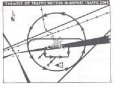azpilot
Line Up and Wait
- Joined
- Jul 27, 2015
- Messages
- 823
- Display Name
Display name:
azpilot
Hello fellow pilots. I had a situation yesterday, and I'm looking for feedback on how I could learn. Here is the situation.
The airport I was approaching has a single runway 04/22. I am approaching basically from the North. There is no tower. I make a call at 10 miles out that I'll be full stop. I don't hear any other calls. The winds are favoring runway 4. I call again at 5 miles out that I'll be entering the left downwind to runway 4 on a 45, and that I'm full stop. As I'm entering the downwind midfield I make a call and announce my position and intentions. This is my third radio call.
Additional information - I have three passengers in the plane. It's me, my 11 year old son, my neighbor, and his 11 year old son. Neither my neighbor or his son had ever been in a GA airplane before. I'm really trying to help them have a good experience. (in case you're wondering, W&B was in limits)
At this point, I hear another plane calling for the first time. "Airport traffic, Bugsmasher 123 entering the left downwind for runway 22, touch and go".
Wait... Did I hear that right??? What are they doing??? I call back on CTAF and ask the other plane to clarify. He basically repeats the same thing. I'm not quite sure what to do, so I announce that I'll do a right 360 for spacing. We seem to basically be in the exact some spots on opposite sides of the airport for the opposite runways. Then when I'm about halfway through my 360, another plane announces that he's 2 miles to the North and is going to cross mid field and then make a right 270 to join left traffic for 22.
At this point I'm pretty flustered. There's two other planes flying the 22 pattern, and I'm in the 04 pattern, but the winds are favoring 04. After completing my 360, I fly upwind, then enter the left traffic for 22 along with the other two planes. The plane that crossed mid field did extend quite a bit out away from the airport to give me plenty of room, which was nice. But the plane doing T&G's kept at it. After landing I observed the windsock. It appeared to be showing about a 5 knot tailwind for runway 22.
Most of the flying I do is at towered airports. I'm not terribly accustomed to non-towered fields. All three of us pilots worked together to make the spacing happen. I did change up my plans and adapted to the situation.
Questions.
1 - Is this kind of situation "normal" for non-towered airports? Am I making a big deal about nothing?
2 - Is there something I could have, or should have done differently here?
3 - What are some things I can learn about how to operate more safely in a non-towered environment?
The airport I was approaching has a single runway 04/22. I am approaching basically from the North. There is no tower. I make a call at 10 miles out that I'll be full stop. I don't hear any other calls. The winds are favoring runway 4. I call again at 5 miles out that I'll be entering the left downwind to runway 4 on a 45, and that I'm full stop. As I'm entering the downwind midfield I make a call and announce my position and intentions. This is my third radio call.
Additional information - I have three passengers in the plane. It's me, my 11 year old son, my neighbor, and his 11 year old son. Neither my neighbor or his son had ever been in a GA airplane before. I'm really trying to help them have a good experience. (in case you're wondering, W&B was in limits)
At this point, I hear another plane calling for the first time. "Airport traffic, Bugsmasher 123 entering the left downwind for runway 22, touch and go".
Wait... Did I hear that right??? What are they doing??? I call back on CTAF and ask the other plane to clarify. He basically repeats the same thing. I'm not quite sure what to do, so I announce that I'll do a right 360 for spacing. We seem to basically be in the exact some spots on opposite sides of the airport for the opposite runways. Then when I'm about halfway through my 360, another plane announces that he's 2 miles to the North and is going to cross mid field and then make a right 270 to join left traffic for 22.
At this point I'm pretty flustered. There's two other planes flying the 22 pattern, and I'm in the 04 pattern, but the winds are favoring 04. After completing my 360, I fly upwind, then enter the left traffic for 22 along with the other two planes. The plane that crossed mid field did extend quite a bit out away from the airport to give me plenty of room, which was nice. But the plane doing T&G's kept at it. After landing I observed the windsock. It appeared to be showing about a 5 knot tailwind for runway 22.
Most of the flying I do is at towered airports. I'm not terribly accustomed to non-towered fields. All three of us pilots worked together to make the spacing happen. I did change up my plans and adapted to the situation.
Questions.
1 - Is this kind of situation "normal" for non-towered airports? Am I making a big deal about nothing?
2 - Is there something I could have, or should have done differently here?
3 - What are some things I can learn about how to operate more safely in a non-towered environment?



